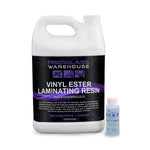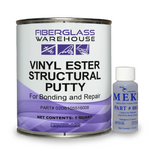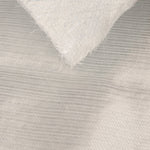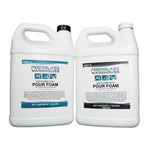You have no items in your shopping cart.
Gel coat has many uses including mold construction, manufactured parts, cosmetic gel coat repairs and yacht/boat construction. The application process is slightly different for each use but hopefully this guide will give you a good idea of what needs to be done when working with gel coat.

Details:
Gel coat is a formulated polyester resin that is designed to be used as a protective or decorative coating on fiberglass parts and in molds. Gel coats are a two-part system that cure at room temperature with the use of MEKP catalyst. It is designed to create a beautiful high-quality finish.
Our white, black and custom colored gel coats are a superior grade ISO NPG polyester resin. They are made with the highest quality modified polyester resin which provides enhanced flexibility and strength. Gel coat can be applied with a brush, roller or sprayer but we highly recommend you spray it on for the best finish. Spraying the gel coat will give the best cosmetic results without much sanding needed after cure. It is recommended to use a gel coat spray gun specially formulated for gel coats, such as the G-100 Gel Coat Cup gun. A paint gun can be used, but you need to be very careful that the gel coat does not kick off inside the gun and you have plenty of acetone around to clean out the gun after each spray.
Preparation:
It is ideal to work in 70-80°F degrees but work can still be done in temperatures ranging anywhere between 60-90°F degrees. Take the ambient temperature into consideration when choosing when to do your project. You can vary the amount of MEKP to slow down or speed up the cure process. But there is a point where it can be too cold or too hot to use gel coat or any resin effectively.
If you will be re-applying gel coat to an existing gel coat surface, make sure to sand the surface well before applying new gel coat. This will allow the new gel coat to adhere well to the surface. If your area is painted, completely remove the paint before adding gel coat as the paint could inhibit the adhesion of the gel coat.
Have styrene monomer out and ready to thin the gel coat. Use no more than 10% by volume. Thinning the gel coat gives it a better flow when spraying. It can also reduce brush marks. You can use acetone as well but it is far inferior to styrene as it could inhibit the crosslinking of the gel coat.
If using a paint spray gun, have some acetone nearby to immediately clean the gun when finished so the gel coat does not harden inside. You will need to dismantle the entire gun.
If using pigments to color the gel coat, have them out.
Tape off sections you do not want to get gel coat on and use tarps.
Wear safety clothing including gloves, a respirator and goggles.
Make sure your surface is clean. It is important to start gel coating your surface soon after cleaning it to avoid additional dust and contaminates settling again. Acetone can be used to clean the area.
Application:
Work in a well-ventilated area.
Use mixing cups to measure the resin. Make sure to work in small batches.
If adding pigments, add before the MEKP catalyst. You can add up to 1% pigment to already colored gel coat, or 10% to unpigmented gel coat.
Use MEKP between 1% and 2% by volume of resin. We recommend 1.25% to 1.75% depending on the desired pot life and working time. The more MEKP added, the shorter the pot life/working time. The less MEKP that is used, the more pot life/working time. It is important that you do not add too little MEKP or it will not cure. If you add too much it will cause shrinkage, pinholes, blistering and the gel coat will gel too quickly. Also, take into consideration the temperature you are working in when choosing how much catalyst to add.
Mix the resin and MEKP hardener thoroughly
***Some gel coat guns mix the resin and MEKP as it is sprayed. If this is the case, follow the instructions that came with the gel coat gun.
When spraying, spray the gel coat on until it is approximately 18-20 mils (thousandths) thick. This will allow for a proper cure. Follow instructions on the box for your gel coat gun. Allow time in between layers for the gel coat to set. The timing will depend on the temperature you are working in and the amount of MEKP that was used. You do not need to wait until it is completely cured. Just until the gel coat has thickened and is no longer liquid. This is referred to as “gelled”.
If you use a paint spray gun instead of a gel coat spray gun, you will need at least a 2mm spray nozzle. As mentioned before, the paint gun will need to be cleaned out immediately after spraying so the gel coat does not clog it up and harden inside.
If you choose to brush the gel coat, just be aware that the finished part could look inferior to a sprayed finish. You will want to use long, even strokes. Use a quarter inch nap roller to apply the gel coat. Wait until the gel coat has set (not completely cured) before adding the next layer.
Again, gel time will depend on how much MEKP hardener was added and the temperature of the room.
You will want your last exterior layer to have wax in it otherwise it will cure with a tacky finish. The wax creates a barrier between the gel coat and the air that in turn produces a hard tack free finish. You can buy some gel coat with wax already added. Or, you can add surface seal (4 oz per gallon) to the unwaxed resin for the last coat, cover with wax paper or use PVA.
After gel coat has hardened, start sanding at around 320-400 grit and work to a finer grit sandpaper to get a nice smooth finish.
Important Notes:
Gel coat coverage depends on how thick you apply it but a gallon will yield approximately 35-75 square feet.
It is important to note that the Orca Guard Polyester ISO NPG cannot be used over epoxy resin. It will not adhere well.
You can purchase gel coat with or without wax. Without wax lets you apply several layers without the need to sand in between. With wax is generally used for the final layer and cures to a hard tack free finish.
If you are new to gel coat, start with a small section and test it out. This will give you an idea of how things will work on a larger part.
Store gel coat in a cool, dry area away from sunlight or heat sources. Polyester gel coat has a limited shelf life. If stored for too long, it will gel in the can without the addition of MEKP catalyst.
To avoid any issues when working with gelcoat, check out our Ultimate Gel Coat Troubleshooting guide HERE.
Still have questions? You can email us at sales@fibergalsswarehouse.com or call 833-669-7899. Our customer service representatives are happy to help.
comments (22)
-

-
 Daniel
DanielHow long can I wait between unwaxed and waxed coats? I am less concerned about minimum times and more about a possible maximum. I have laid two coats unwaxed and was not able to do a final waxed coat, it has been approx. 2 weeks, do I need to sand before doing final coat or just wipe down with acetone and do final waxed coat?
-
 Fiberglass Warehouse
Fiberglass Warehouse@Michael Wilkinson -
Ok, you have a lot of questions here.
1. You can use fumed silica to make a gel coat paste and fill your gouges then sand buff and polish. For this, I would use waxed gel coat so you can sand, buff and polish. Typically you would build up the gouge above the level so you can sand it down.
2. Sanding is the only wax to remove it without buying a dewaxer. Normal solvents won’t take it off.
3. It is up to you if you want to sand, then gel coat the whole boat. That is a lot more complicated that you think because you will need to sand, buff and polish after you roll or spray the hull. Orca Air Dry Super Clear will help the gel coat flow so you don’t have to sand buff and polish as much. -
 Michael Wilkinson
Michael WilkinsonMay I thicken Black Gel Coat with Fumed Silica to make a gelcoat patching putty / fairing compound that I can then fair and buff the same as gelcoat?
If my gelcoat has wax, then must I sand between coats, or can I apply multiple layers after just a few hours without sanding?
Is sanding the only way to remove the wax, or can it be removed with solvents?
I have a hull with a lot of chips of gelcoat. Would the best strategy be to sand, patch, and fair the chips with a thickened gelcoat, then come back and sand the entire hull and apply a sprayed on gelcoat over the entire hull to refresh the whole thing and get a perfect colormatch? Then sand and buff to a medium gloss finish… -
 Fiberglass Warehouse
Fiberglass Warehouse@Tim- It is mils which is thousandths not millimeters. Hope that helps!










It is probably still tacky. Take a rag with acetone and swipe across the gel coat and see if it tacks up. If it didn’t tack up, you will need to sand.